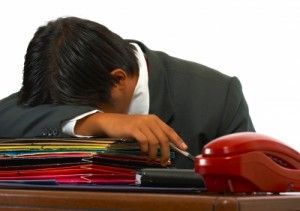Blog
Sleep Loss Costs Billions: video lesson with gap-fill
- septiembre 20, 2011
- Posted by: Joel
- Category: Gap-Fill Exercises Listening Video With Text
Discuss these questions before you watch.
What is insomnia?
Why do you think this is a problem?
Watch the video answer the following questions. Then, watch again and read to check your answers.
How many days of work per year do tired workers lose on average?
Are female or male workers more prone to this problem?
How much do insomnia treatments cost per year?
Watch the video and put these words into the correct gap: habits, prone, illness, missing, lack, link
Transcript By Kim St. Onge: New statistics might serve as a wake up call for some insomniacs. A recent study shows that __________ of sleep costs the U.S $63.2 billions a year in productivity.
Dr. Ronald Kessler found that dead tired U.S. workers lose on average the equivalent of 11.3 days a year. Andhran News reports — Kessler says the problem with insomnia isn’t about employees missing work.
“It’s an under appreciated problem. Americans are not __________work because of insomnia. They are still going to their jobs but accomplishing less because they’re tired. In an information-based economy, it’s difficult to find a condition that has a greater effect on productivity.”
The Sleep Journal says the study isn’t an eye opener. In fact, it’s more of a snooze.
“As experimental studies increasingly __________ insomnia with a range of negative effects on functioning, from increased sleepiness and fatigue to reduced psychomotor performance… it is unsurprising that insomnia has been associated with significant workplace deficits.”
The study sampled 7,428 employees and asked them about sleep __________ and work performance. USA TODAY also reports a link between sleep habits and school.
“The researchers also found that insomnia rates were 19.9 percent for those with less than a high school education and 21.5 percent for college graduates.”
But KBOI radio reports — the study proved education isn’t the only contributing factor.
“The study also found that insomnia affected only 14.3 percent of workers aged 65 and older, and that female employees were more __________ to it than their male counterparts — 27.1 percent to 19.7 percent, respectively.”
In a Science Daily article — sleepmaster Kessler explains why the negative effects of wide-eyed nights are often overlooked.
“Accurate estimates on the costs of insomnia in the workplace might justify the implementation of screening and treatment programs for employees. Because insomnia is not considered an __________ — the kind that results in lost days at work — employers tend to ignore its consequences.”
Insomnia treatment ranges from about $200 a year for generic sleeping pills to as much as $1,200 for professional therapy.
Vocabulary: look these words up in the dictionary and write a sentence with each
A wake up call
Information-based economy
Performance
To be prone to something
Generic pills
photo by nunnui

